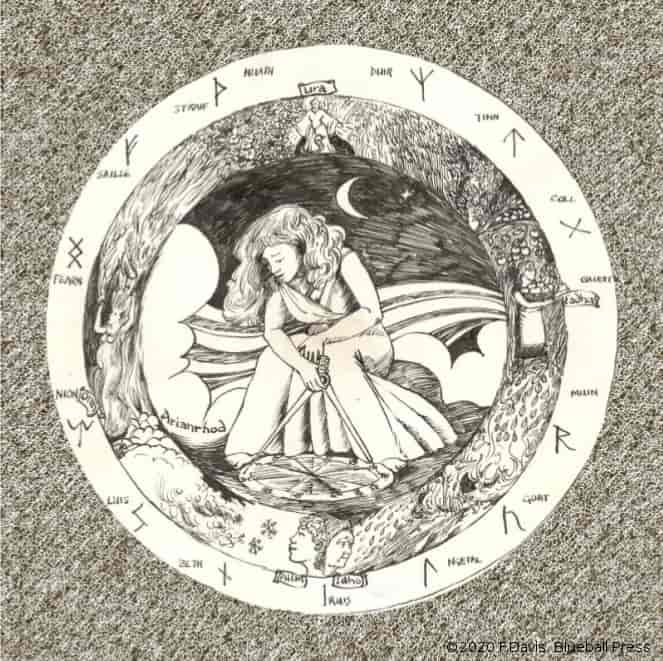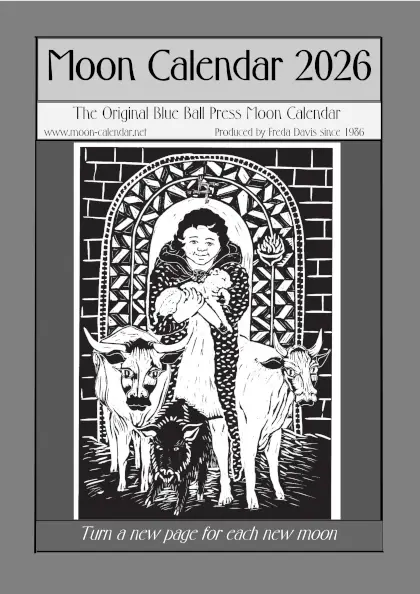What is the Moon Calendar?
On this page:
> About this Moon Calendar
> Moon years, Sun Years, the Great Year
> Time and the Moon Calendar
> The Wheel of the Year
> Naming The Moons
> Sources
The Moon Calendar, in contrast to the more familiar sun calendar, is based on the moon’s rotation about the earth, rather than the earth’s around the sun. For prehistoric societies, the moon’s phases held a special meaning and formed an essential part of their paradigm of life.
This moon calendar describes ancient pagan lore and mythical associations with the moon seasons, astrological sun signs, runic and Druidic links, and other traditions. It marks festivals from different faiths throughout the year, and some non religious celebration dates. Many of these systems have nature-based and seasonal origins.
The Moon Calendar presents the year from a lunar perspective, as people experienced the world for centuries before the Patriarchal imposition of calendars that ignored the phases of the moon, which is our most visible marker of the changing year. It recalibrates Gregorian calendar dates by putting each moon on its own page, highlighting the phases and gathering together the beliefs and mythology associated with our northern hemisphere, our seasons and our mixture of Celtic, Anglo-Saxon, and Norse beliefs along with more distant tales. Not just Pagan, but religious celebrations marking the changing seasons, dates of festivals and holy days for all major religions. Every page has a seasonal pen and ink illustration and a summary of the season. A wealth of detail from eclipses to runic symbols and the druidic alphabet.
For a technical almanac of the moon’s phases and seasons, there are other good web sites such as Timeanddate.com or Moongiant. Our Moon Calendar focuses on Pagan lore, and presents a beautifully illustrated month-by-month rendering.
About this Moon Calendar
This Moon calendar, or Lunar Calendar, draws inspiration from the common spirit of different European traditions and mythologies; From the Gaul’s Coligny Calendar, the Celtic Tree Calendar, Druidic and Anglo-Saxon traditions.
The 2026 calendar has a focus on Saint Brigit and her pagan origins.The cover image is from a linocut of St Brigit, a saint as important to Ireland as St Patrick.
Some guidance is given on the character of each moon season with its characteristics, associated trees or plants, and names by which they have been personified and sometimes worshiped. The Germanic Rune and its name are given, with its meaning in English. The Sun signs from Astrology have been included, and letters from the Druidic alphabet but also the eclipses of sun and moon.
The calendar is based on the pagan tradition of celebrating the cycle of the year. Celebration and awareness of the changing seasons is health-giving and brings us close to nature. Religion, or Res Ligio means the rules by which we live. Many celebrations and duties have grown out of the natural order and cycle of the seasons. These are supported by myths and tales which give meaning to our lives.
Significant days from religions and other traditions have been included. Some of these point to links with natural events and seasonal concerns and provide common ground for celebration.
The philosophy of this calendar is our shared belonging to mother earth.
Moon years, Sun Years and the Great Year
The moon’s cycle slips back and forth in her relation to Sun festivals.
There is a ‘Great Year’ cycle of nineteen years, where solar and lunar times catch up with each other. This includes about seven extra moons over the nineteen years. So in some years an extra moon makes a longer Summer or Winter, to keep the moons in synchrony with the Sun’s cycle. This is called ‘intercalation’.
Time and the Moon
This is an Anglo-Centric calendar. The moon phases are given at Greenwich Mean Time (GMT or UTC) in London. NOT British Summer Time (BST)!
If you live in a different time zone you need to add or subtract hours as appropriate. (e.g. subtract 5hrs for New York Time.) Our Moon Calendar is also based in the Northern hemisphere. Because of the tilt of the Earth, seasons in the Southern hemisphere are quite the opposite and some dates, such as Summer and Winter Solstices and the Equinoxes are reversed, as are the Pagan Festivals.
However, apart from the time zone difference, we are all seeing the same phase of the same moon. The weather frequently changes on a new moon. Some Moon names reflect the season in the temperate zone of the Northern hemisphere, as they are drawn from Celtic and Anglo Saxon origins.
The Wheel of the Year
This is Arianrhod’s Silver Wheel of the Year.
The drawing is based on Robert Graves’ book ‘The White Goddess’
In the outer circle it shows the runes connected to each of the moons around the year.
In the inner wheel it shows the five personifications of the Earth Goddess. In early times there were representations of women in positions of power and contributing skills and judgement to the life of the community. They are recorded as goddesses.
The image shows the five stages of the year, stages in a woman’s life: the earth goddess is identified as as a maiden, a fertile woman, a woman of power, a nurturing woman, and a wise woman.
Graves also says that the names associated with each are also the five basic vowels:

A for Ailm the maiden, with the Silver Fir being the birth tree,
O for Onn, young fertile woman, the furze or gorse golden at the spring equinox,
U for Ura, the mature and powerful woman, the Heather, red and passionate,
E for Eadha, the protector of the home, the aspen or white poplar, a shield material,
I for Idho, wise woman, linked to the Yew tree and acceptance of life’s ending.
(From ‘The White Goddess’ by Robert Graves.)
Naming The Moons on the Moon Calendar
Feast of New Fire, as Sun’s Moon swells in sky.
Then Earth’s Moon, as seeds sprout under soil.
Balance Day and Night: New Life Feast, Moon of Eggs. Easter follows the full moon.
Dangerfire: Lucky’s Moon; Green leaf and grass blade.
Moon of Blossoms, Moon of Bees, for Lith at Solstice.
Sky’s Moon: sun is overfull but Look not Sadly.
Gatherer’s Moon: Set store by, like squirrel. Balance Night and Day:
Windy Moon blows change.
Moon of Blood for Hunters; leaf red and sunfire dying.
Moon of Water, Moon of Ice for Yule and Solstice.
In the gracious Year, Moon of Plenty.
In the long year, Moon of Hunger.
Sources for the Moon Calendar
Sources used for the Moon Calendar include:
Runestaves and Oghams, Nigel Pennick, pub. Runestaff-
The Druid Renaissance, Ed Philip Carr-
Leaves of Yggdrasil, Freya Aswynn, self published 1988
The White Goddess, Robert Graves, Faber and Faber 1984
